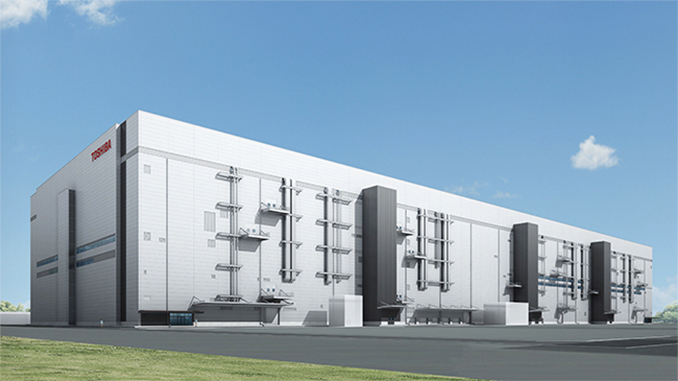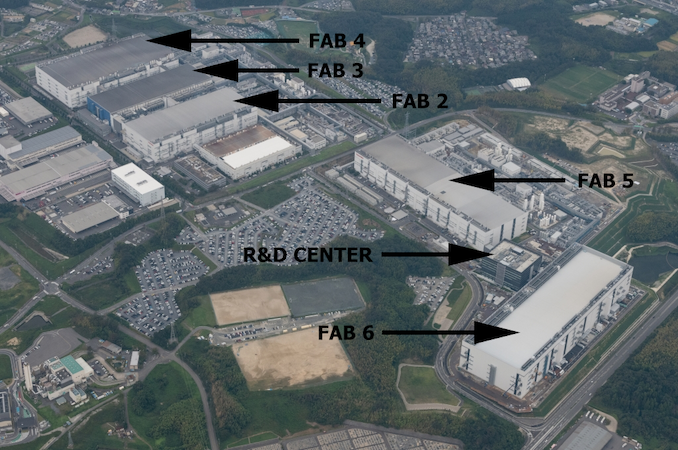Toshiba & WD NAND Production Hit By Power Outage: 6 Exabytes Lost
by Anton Shilov on June 28, 2019 12:15 PM EST
Toshiba Memory and Western Digital on Friday disclosed that an unexpected power outage in the Yokkaichi province in Japan on June 15 affected the manufacturing facilities that are jointly operated. Right now, production facilities are partially halted and they are expected to resume operations only by mid-July.
Western Digital says that the 13-minute power outage impacted wafers that were processed, the facilities, and production equipment. The company indicates that the incident will reduce its NAND flash wafer supply in Q3 by approximately 6 EB (exabytes), which is believed to be about a half of the company’s quarterly supply of NAND. Toshiba does not disclose the impact the outage will have on its NAND wafer supply in the coming months, but confirms that the fabs are partially suspended at the moment. Keeping in mind that Toshiba generally uses more capacity of the fabs than WD, the impact on its supply could be significantly higher than 6 EB with some estimating that it could be as high as ~9 EB.
Both companies are assessing the damage at the moment, so the financial harm of the incident is unclear. Not even counting potential damage to production tools and other equipment used at the fabs, 6 EB of NAND cost a lot of money. Furthermore, analysts from TrendForce believe that a consequence of the outage will be some loss of confidence from clients of both companies, which will have a financial impact as well.
The Yokkaichi Operations campus jointly owned and run by Toshiba and Western Digital produces about 35% of the global NAND output in terms of revenue, according to TrendForce. At present, the manufacturing base has five production facilities (Fab 2, Fab 3, Fab 4, Fab 5, and Fab 6) as well as an R&D center, all of which were affected by the outage. Three fabs within the campus produce 3D NAND flash, whereas another two are used to make special-purpose types of memory.
Considering the gargantuan size of the Yokkaichi Operations, disruptions of its supply will inevitably have an effect on 2D NAND and 3D NAND spot prices in the short-term future. Nonetheless, since contract prices have already been set for Q3 (and possibly Q4), they are not going to change. Meanwhile, it remains to be seen whether large customers will have to go shopping in Q3 or Q4 and affect prices on the spot markets further.
Considering that the Yokkaichi Operations produces at least 1/3 of the global NAND flash output (let’s assume that dollar share more or less corresponds to bit share) and half of its production for the quarter was lost because of the incident, this means that the industry will miss approximately 1/6 (or 16.5%) of the global NAND supply in Q3. Whether or not this will create a deficit on the market that will cause significant price hikes depends on multiple factors and is something that remains to be seen.
Related Reading
- Toshiba Memory and Western Digital Open Fab 6 and New Memory R&D Center
- Toshiba Memory & Western Digital Finalize Fab K1 Investment Agreement
- Toshiba Begins to Construct New BiCS 3D NAND Fab in Iwate Prefecture
- Toshiba Memory to Build New Fab to Produce BiCS 3D NAND
- Toshiba Finalizes Plans for New 3D NAND Fab: Coming Online in 2019
- Toshiba to Build New Fab to Produce BiCS NAND Flash
Sources: Western Digital, Reuters, TrendForce, Blocks & Files












148 Comments
View All Comments
eva02langley - Monday, July 1, 2019 - link
We are not talking about UPS there. A generator is not a stable source of power. It introduce a lot of noise. Also, silicon fabs use a huge amount of power in their process that no backup power can provide.We don't know how this affect the would supply chain because we are not in the industry. Seeing smart idiots claiming they know better is just ridiculous.
eva02langley - Monday, July 1, 2019 - link
whole not wouldmat9v - Tuesday, July 2, 2019 - link
Are you absolutely sure of that? How much power exactly does it take? ASML machines that actually make the product use pretty weak lasers, on the whole current best ones (strongest) use 250W. You don't want to evaporate metals there, you want to, so to speak, shine some light at the correct frequency - it's not a brute force approach but a finesse one. I'm sure much more power is used for filtering atmosphere, temperature control or simple lights then it is on actual lithography.The generator may not be stable power source but power lines are not stable too, you really think the power is not filtered, stabilised and converted as many times as needed?
Besides, battery backup they had is not stable either, no matter what type of batteries the used, voltage decreases a lot during discharge, they must have a lot of stabilization going on, you think that would not be capable of stabilizing generators?
The only explanation is they did not turn the generators on counting on power being restored or the whole "accident" is a scam created for unsold inventory, insurance claim and future prices increase.
With only one "stroke" you get a lot of benefits.
whyaname - Friday, July 5, 2019 - link
@eva02langleyGenerators are not stable power sources?
Well I am of to all power plants around the world telling them your conclusion that whatever they use is not stable and that we should replace it with solar panels even if it needs 50-100 the area of a nuclear plant to produce the same amount of energy under good conditions.
eastcoast_pete - Friday, June 28, 2019 - link
Battery- and generator-power can only support the security and absolutely essential systems for more than a few minutes. These fabs draw hundreds of megawatt a piece, and essentially any silicon that isn't fully finished is basically lost once the power goes out. The only way to be able to go off-grid for such fabs is an on-site power station, and that you'd need backups for that, because they also go down or need maintenance.mat9v - Sunday, June 30, 2019 - link
Are you absolutely certain that there are no points at which, in the hundreds steps process, production can not be halted? Does all the phases happen on one sealed chamber or does the wafers being processed travel between different chambers in the fab?Dug - Monday, July 1, 2019 - link
You don't understand. Even something simple like baking the wafers can't be interrupted. If the process takes 1 continuous hour, and you lost power for 13 minutes, then you lost everything. There's so many processes that you can't just shut down and start back up again in the middle.mat9v - Tuesday, July 2, 2019 - link
Well, then if you are aware of that, then you create a solution that will deliver power for the required time. If not you are a moron, or you are counting on insurance to cover your ass.zanon - Monday, July 1, 2019 - link
Not him and late, but yes, absolutely certain. It's genuinely hard to overstate how insanely precise the timing and stability requirements of each step are when you're literally, LITERALLY talking "3 atoms is too thin, 5 atoms is too thick". The modern silicon fabrication process is genuinely one of humanity's greatest wonders. If you haven't seen it, a good little talk is "Indistinguishable From Magic": https://www.youtube.com/watch?v=NGFhc8R_uO4Keep in mind that everything you here in there is now very old and obsolete tech too.
FullmetalTitan - Friday, June 28, 2019 - link
These facilities pay out the nose for power assurance from local utilities. They get the same guarantees as hospitals.They also have banks and banks of UPS systems, like thousands of batteries, and even then can only supply critical safety systems for more than a few minutes.
The Samsung fab in Austin I live near has its own power substation in case you need a good indicator of how much power these facilities use. The Yokkaichi complex is about 3x that size